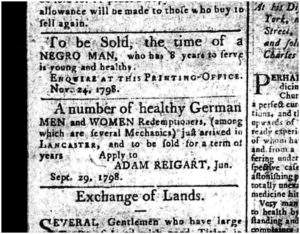Healthy German Men and Women To Be Sold…
Newspaper Ad from 1798

A number of healthy German MEN and WOMEN Redemptioners, (among which are several Mechanics) just arrived in Lancaster, and to be sold for a term of years. Apply to Adam Reigart, Jun.
This advertisement ran in the Lancaster Journal newspaper on December 29, 1798. Why are German men and women being sold by Adam Reigart, a local merchant who was generally known for selling wine and spirits? And what’s a “Redemptioner?”
Tiered System of Labor
According to Cheesman Herrick, the author of White servitude in Pennsylvania: Indentured and redemption labor in colony and commonwealth, the economic potential of America’s natural resources was offset by the lack of labor in the sparsely populated colonies. In order to create the requisite pool of labor, the American colonies established a three-tiered system of labor:
- Free labor who could bargain for wages, who were hired, and who could withdraw from their employment at any time;
- Indentured/Redemptioned laborers who lived in servitude for a set number of years in exchange for passage to the American colonies from England or Germany. They were considered chattel that could be bought and sold until the period of their servitude expired;
- Slave labor who lived in servitude, who were considered chattel, and who had no expectation of ever being free.
Indentured Servants vs. Redemptioners
Herrick says that the term “indentured” is usually applied to servants from Great Britain. British regulations required that a labor contract had to be completed before an emigrant could board a ship bound for the colonies. However, German emigrants were not bound by the British regulations. They would sign an agreement with the ship’s captain to pay a certain sum after landing at the colonies. If the emigrant failed to find someone to pay the amount owed to the ship’s captain, s/he would be sold as property by the ship captain. The person sold was called a Redemptioner. She would then work a set number of years for her owners before she could be live freely in the colonies.
Looking at Reigart’s ad in the Lancaster Journal, we can assume that Adam Reigart had bought two Redemptioners, perhaps in Philadelphia, and was selling them as property.
Also, note the ad above, “To be Sold, the time of a NEGRO MAN, who has 8 years to serve, is young and healthy.” Because this man has “8 years to serve”, we can assume that he was also indentured and was not a slave. But consider the nature of the labor market that someone is selling by the hour the services of indentured servant.
Further Information
If you are interested in getting more information about indentured servitude…
- You can search LancasterHistory.org’s library catalog at https://lhdo-verso.auto-graphics.com/MVC/. You can search for this topic by using the official Library of Congress subject headings: <redemptioners> and/or <“indentured servants”>. Be sure to use the quotation marks around “indentured servants”. That way the catalog will search for that exact phrase.
- You can read Cheesman Herrick’s White servitude in Pennsylvania in LancasterHistory.org’s library. Its call number is 331.62 G566. You can view the library record here.
- You can read what some person somewhere, we don’t know who, says about indentured servitude in Pennsylvania at Wikipedia here.
As for Adam Reigart, LancasterHistory.org has a collection of items related to his business. You can find a detailed description of that collection here. If you want to view items from that collection, please come into the library and put in an archive’s request for the materials you want to view.
This is an entry from Notes From the Library by Nathan Pease, Director of Library Services.
The Library at LancasterHistory.org has collected materials about Lancaster County for over 100 years. All the while, the librarians have been creating multiple tools to help patrons find relevant information. This blog will feature items from the collection as well as tips and tools for searching and discovery.
From Notes From The Library